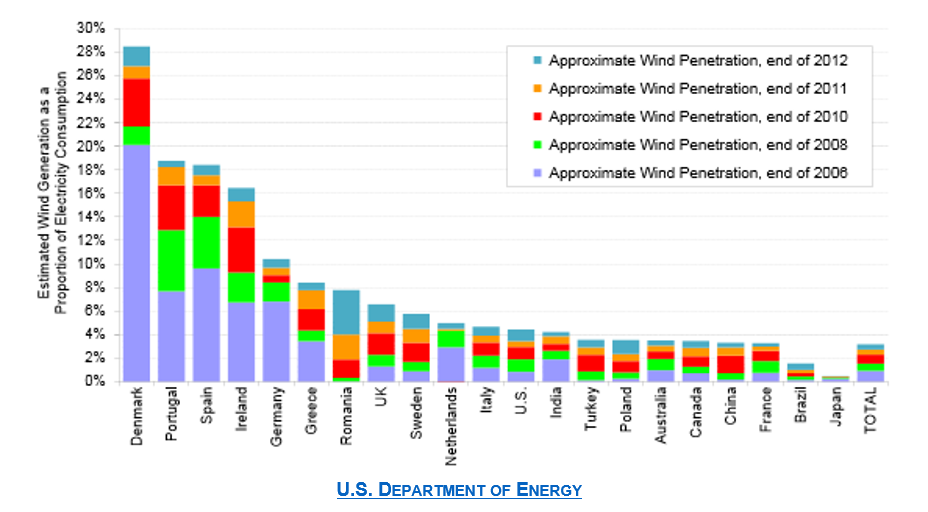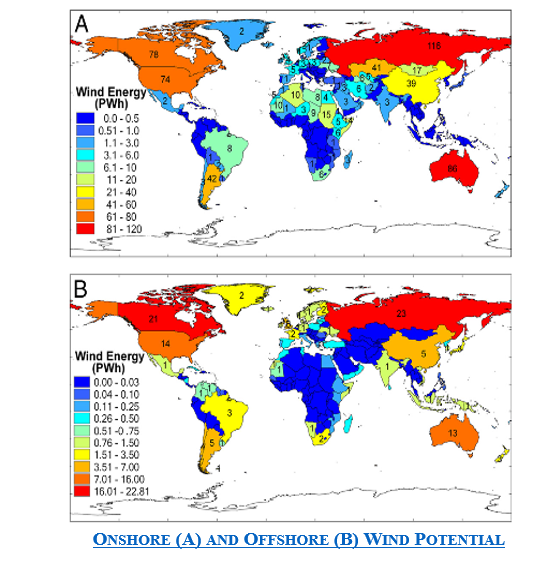North America Falling Behind in Wind Power Market Penetration and Integration
Posted by Raymond Bedard on August 25, 2014
Skeptics often boast that as an energy source, wind power can’t effectively meet a significant proportion of national energy demand, with upper limits of penetration at around 10 per cent. These skeptics cite issues such as the intermittent nature of wind power or high capital costs as justification for wind power’s limited potential. As loud as these skeptics may be, nobody seems to have heard them in Europe where wind power generation has been defying these limits and breaking records throughout 2013 – perhaps it’s all that low frequency noise.
In Denmark, wind energy supplied over 33 per cent of the nation’s total electricity demand for 2013 and almost 55 per cent of the country’s energy demands in December. On more than one occasion, Denmark’s wind power output surpassed national demand, such that the country was operating on 100% wind power with plenty to spare. Wind power was Spain’s top source of electricity in 2013, delivering 21.1 per cent of the nation’s total demand. Right next door, Portugal generated over 70 per cent of its power from renewable energy sources in the first quarter of 2013 and has relied on wind power for more than 90 per cent of the country’s energy demand at certain times throughout the year. Wind energy has been able to meet up to 50% of the electricity demand in Ireland when the wind is blowing. And even in Germany, the largest industrial economy in Europe, intermittent renewable energy technologies were able to reliably provide an average of 22 per cent of the nation’s electricity demand in 2013.

It appears these countries have found a way to get past the 10 per cent penetration limit for wind energy. Has Europe developed a cheap and efficient grid scale storage system to compensate for wind power intermittency? No. In fact, Germany estimates that it can triple its current wind capacity before significant amounts of wind power will need to be stored. Cost has proven to be less of an obstacle than skeptics would suggest, with several European countries reporting reduced energy costs as the growing wind power supply offsets the cost of increasingly expensive fossil fuels.
Canada and the U.S. are two of the most developed nations in the world and their large landmasses and long coast lines place them second and third in terms of both onshore and offshore wind potential. Both nations have almost 20 times the annual wind energy potential of Germany. So, if intermittency and cost are not proving to be barriers in Europe, why are Canada and the United States trailing behind in wind power market penetration? The large and robust electricity systems in both countries would be able to manage the intermittency of wind power just as well as the aforementioned European countries. However, the biggest barrier to wind development in North America is cost.
 The U.S. Department of energy estimates the Levelized Cost of Electricity (LCOE) of wind energy at approximately 92 USD/MWh. This is a significant discount when compared against the electricity prices in many European countries. In Portugal, Spain and Ireland, electricity prices are approximately 250 USD/MWh. In Denmark and Germany, consumers are paying 400 and 360 USD/MWh. Electricity prices in North America are significantly lower, ranging between 80 to 170 USD/MWh in the United States and between 54 and 120 USD/MWh in Canada.
The U.S. Department of energy estimates the Levelized Cost of Electricity (LCOE) of wind energy at approximately 92 USD/MWh. This is a significant discount when compared against the electricity prices in many European countries. In Portugal, Spain and Ireland, electricity prices are approximately 250 USD/MWh. In Denmark and Germany, consumers are paying 400 and 360 USD/MWh. Electricity prices in North America are significantly lower, ranging between 80 to 170 USD/MWh in the United States and between 54 and 120 USD/MWh in Canada.
In the European Union, over 60 per cent of electricity is generated from natural gas or oil. Although natural gas electricity production is slightly cheaper than wind power in North America, natural gas prices are more than twice as high in Europe, and almost three times as high in Germany, in particular. The high price of electricity and natural gas in Europe make wind energy an attractive option as a low cost, low emissions alternative.
In most of North America, the delivered price of electricity is competitive with the LCOE of wind energy which does not include distribution charges or profit for energy producers. At current electricity rates, wind energy is not economically competitive in most of North America, and the key incentive for wind energy development is greenhouse gas reductions. Greenhouse gas reductions are hard to sell to customers and, more importantly, voters when they see the costs reflected in their utility bill.
In order for wind energy to see greater market penetration in North America, electricity prices will need to rise - but are rising electricity bills such a bad thing? Canada has one of the lowest electricity prices in the world and this has led to Canadians having the world’s highest per capita household electricity consumption. Governments and utilities simultaneously advocate for energy conservation, while keeping electricity and fossil fuel prices artificially low, which only serves to promote consumption.
If North Americans intend to get serious about reducing greenhouse gas emissions and promoting energy conservation, we will need to start investing in clean and renewable energy sources. Such investments are less critical in jurisdictions such as Quebec and Ontario where the GHG intensity of electricity is already quite low due to high hydroelectric and nuclear power output. However, much of the U.S. and Canada is still reliant on coal, the energy source with the highest GHG emissions per kWh, and natural gas. While coal systems are currently economical, some studies suggest the actual cost of coal is up to three times current estimates once contaminated drinking water, health impacts for miners, increased lung cancer rates and ecological impacts are considered. And although natural gas prices are currently low in North America, fossil fuel markets are notoriously volatile, as citizens of Ontario can attest to after the province’s recent 40 per cent increase in natural gas prices. The financial disadvantages of coal and natural gas do not even take into account the potential impacts of an imposed carbon tax – a scenario which appears so inevitable that even oil giant Exxon Mobil has begun to incorporate it into their balance sheets.
There is no single solution to the world’s energy problems, but wind power is certainly able to make a much larger contribution than the skeptics thought, and at a much more competitive price. Europe, and increasingly Asia, are both leading the way in renewable energy development and it’s time for North America to start playing catch up.
Edited from original submission.
Filed under: Students on Sustainability